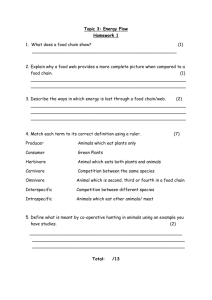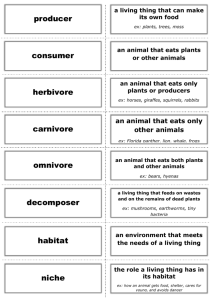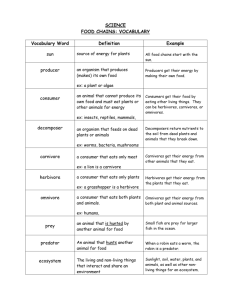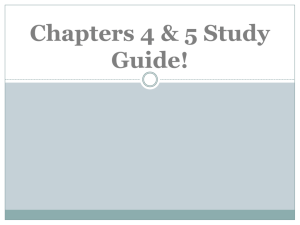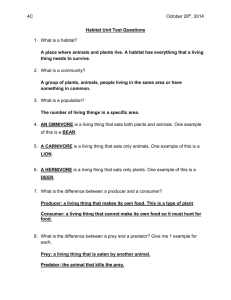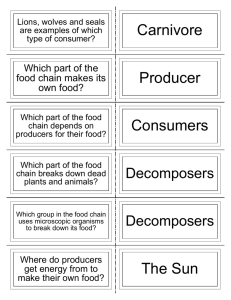Lesson Plan & Rubric
advertisement
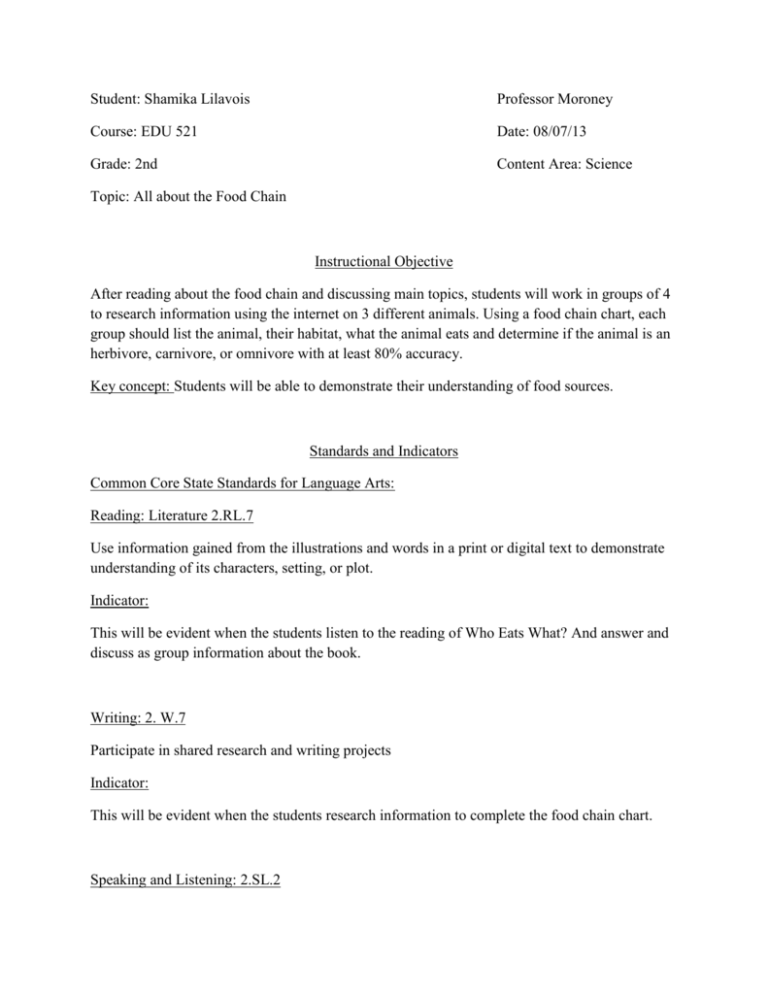
Student: Shamika Lilavois Professor Moroney Course: EDU 521 Date: 08/07/13 Grade: 2nd Content Area: Science Topic: All about the Food Chain Instructional Objective After reading about the food chain and discussing main topics, students will work in groups of 4 to research information using the internet on 3 different animals. Using a food chain chart, each group should list the animal, their habitat, what the animal eats and determine if the animal is an herbivore, carnivore, or omnivore with at least 80% accuracy. Key concept: Students will be able to demonstrate their understanding of food sources. Standards and Indicators Common Core State Standards for Language Arts: Reading: Literature 2.RL.7 Use information gained from the illustrations and words in a print or digital text to demonstrate understanding of its characters, setting, or plot. Indicator: This will be evident when the students listen to the reading of Who Eats What? And answer and discuss as group information about the book. Writing: 2. W.7 Participate in shared research and writing projects Indicator: This will be evident when the students research information to complete the food chain chart. Speaking and Listening: 2.SL.2 Recount or describe key ideas or details from a text read aloud or information presented orally or through other media. Indicator: This will be evident when the students discuss with the teacher and one another the makings of a food chain. NETS Standard 2: Communication and Collaboration: Students use digital media and environments to communicate and work collaboratively, including at a distance, to support individual learning and contribute to the learning of others. Indicator: This will be evident when students work in groups to research 3 different animals. Standard 3: Research and Information Fluency: Students apply digital tools to gather, evaluate, and use information. Indicator: This will be evident when students gather information about 3 different animals. Motivation The teacher will ask students about their favorite foods and where they think their food comes from. Materials Flash Cards Laptops Food Chain Chart SMART Board Who Eats What? Food Chains and Food Webs FM system Strategies Direct teacher instruction, Group discussion Adaptations For the student with a hearing impairment, the teacher will wear a microphone connected to an FM transmitter to allow the student to hear better throughout the lesson. This FM system will be utilized during the class discussion, the book read-aloud, and any other time the teacher speaks. Differentiation of instruction The teacher realizes that students learn differently; therefore videos are easily accessible in the eTextbook, as well as fun games. Developmental procedure (key questions) 1. Students will listen to a reading of Who Eats What? And discuss as a class food chain sequences. (What do all food chains begin with? What do the bigger fish eat? Why do food chains exist? Are you apart of the food chain? ) 2. Students will be put in groups and given flash cards faced down. After being signaled by the teacher, each group will use their flashcards to create a correct food chain sequence. The group who creates a correct food chain in the shortest amount of time wins. (Where is your place in the food chain?) 3. Students will stay with their assigned group. Each group will be given a laptop and a food chain chart. The students will work as team to research 3 different animals utilizing the Patterns in Nature eTextbook, as well as other websites. (What is the name of the animal? Which habitat does the animal live in? What does the animal eat? Which group is the animal in?) Assessment Students will work in groups of 4 to find information on the internet on 3 different animals. Using a food chain chart, each group should list the animal, their habitat, what the animal eats and determine if the animal is an herbivore, carnivore, or omnivore with at least 80% accuracy. (See attached rubric) Independent practice Following the lesson, students will choose one animal their group researched and create a correct food chain sequence. Follow-up Direct Teacher Intervention: For the group who did not meet the objective of the lesson, under direct intervention with the teacher, the teacher will assist students in completing the food chain chart, as well as their short essays. Academic Enrichment: For the group who easily achieves the objective, the students will research 2 more animals from different habitats. Using the food chain chart, each student should list the animal, their habitat, what the animal eats and determine if the animal is an herbivore, carnivore, or omnivore. References English Language Arts Standards. (2012). Retrieved from www.corecommonstandards.org/ELA-Literacy Lauber , P. (1994). Who eats what? Food chains and food webs. HarperCollins Publishers. Lilavois,S., Mannion, K. & Cates, J. (2013). Patterns in nature. Weebly. Retrieved from http://patternsinnature1.weebly.com The food chain lesson. (2005). Retrieved from http://www.instructorweb.com Food Chain Research Project Teacher Name: Shamika Lilavois Student Name: ________________________________________ 4 3 2 1 Cooperative Work The group worked well together with all members contributing significant amounts of quality work. The group generally worked well together with all members contributing some quality work. The group worked fairly well together with all members contributing some work. The group often did not work well together and the game appeared to be the work of only 1-2 students in the group. Quality of Information Information clearly relates to the main topic. It includes several supporting details and/or examples. Information clearly relates to the main topic. It provides 1-2 supporting details and/or examples. Information clearly Information has little relates to the main or nothing to do with topic. No details the main topic. and/or examples are given. Labels At least 90% of the items are labeled and located correctly. 80-89% of the items are labeled and located correctly. 79-70% of the items are labeled and located correctly. Less than 70% of the items are labeled and located correctly. Knowledge Gained All students in group could easily and correctly state several facts about the topic used for the game without looking at the game. All students in the group could easily and correctly state 12 facts about the topic used for the game without looking at the game. Most students in the group could easily and correctly state 12 facts about the topic used for the game without looking at the game. Several students in the group could NOT correctly state facts about the topic used for the game without looking at the game. CATEGORY
